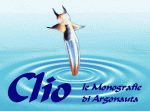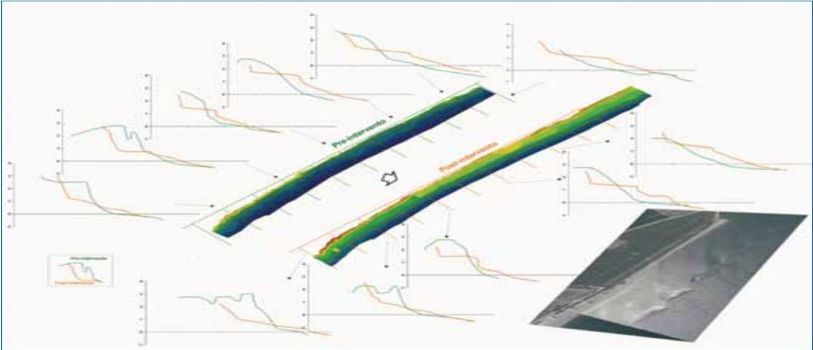
Clio supplemento a Argonauta n. 7-12 2012
 |
 |

|
Il ripascimento può essere di tipo "morbido", costituito cioè da versamenti di sabbie sulla costa, o di tipo "duro" con la realizzazione di barriere in roccia che frenano la violenza del mare, da un lato, e trattengano le sabbie versate, dall'altro.
L'immagine in alto, sempre estratta dai lavori del progetto BEACHMED, mostra i profili pre (linee verdi) e post (linee rosse) ripascimento di una zona sottoposta a opere di difesa costiera. La granulometria media della sabbia determina la conformazione della costa e del fondale e, come visto nella pagina precedente, del rischio che il mare eroda più o meno la costa stessa. Si comprende ora perchè vengano effettuate grandi e costose ricerche sottomarine per reperire materiali sabbiosi idonei al "ripascimento" di una certa zona. Normalmente viene scartato il materiale superficiale "pelitico" in quanto di natura essenzialmente fangosa (vedi immagine sub radar di pagina 005). Ci si orienta quindi su strati inferiori purchè abbiano la granulometria più "compatibile" con quella da difendere e, soprattutto, di misura adatta a garantire un "rotolamento" idoneo a dare al fondale quella inclinazione ottimale vista nella pagina precedente. Parlando dal punto di vista "malacologico" possiamo dirci fortunati in quanto sulle spiagge italiane risultano prevalentemente "utili" sabbie datate circa 8.000-10.000 anni fa che contengono materiale "subfossile" decisamente molto ricco. Le prossime pagine sono totalmente dedicate ad illustrare con ampia iconografia il materiale da noi raccolto in questi ultimi anni. |
The nourishment can be of type "soft", is obtained from deposits of sand on the coast, or type "hard" with the creation of barriers in rock that softened the violence of the sea, on the one hand, and retain the sands paid, other. The image at the top, always drawn from the work of project BEACHMED, shows the pre profiles (green lines) and after (red lines) nourishment of an area subject to coastal defense works. The average particle size of the sand determines the shape of the coastline and seabed and, as mentioned on the previous page, the risk that the sea erodes more or less the coast same. One can understand now why are carried out large and expensive underwater research to find materials suitable for sandy "beach nourishment" of a certain area. Normally, the surface "pelitic" material is discarded because that is essentially muddy (see radar image sub page 005). Then there is a tendency of lower layers provided they have size more "compatible" with that to defend and, above all, of suitable size to ensure a "rolling" liable to give the optimum angle to the bottom view the previous page. Speaking from the "malacological" point of view we are lucky because on Italian beaches are mainly "useful" sands dated about 8000 to 10,000 years ago that contain material "subfossil" very rich. The next few pages are totally dedicated to illustrate the wide iconography material collected by us in recent years. |
